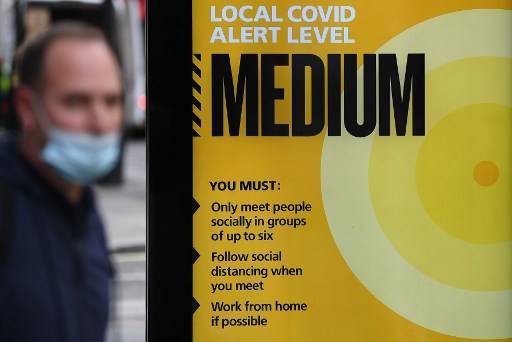
Health Secretary Matt Hancock said the measures, which include a ban on household mixing from Saturday, were necessary to try to halt the exponential spread of the virus.
The curbs will affect some nine million people in the British capital, and more than two million in parts of the southeast, Midlands, north, and northwest.
“In London, infection rates are on a steep upward path and the number of cases are doubling every 10 days,” Hancock told parliament.
“The seven-day average case rate stands today at 97 and rising sharply… We must act now to prevent the need for further measures later on.”
The announcement comes as the government is under mounting pressure to order a two-week “circuit-breaker” lockdown to cut spiralling transmission rates.
On Wednesday, nearly 20,000 new positive cases were recorded across the UK while the number of deaths — 137 — was in triple digits for the second day running.
But Prime Minister Boris Johnson’s favoured approach is a targeted, local three-tier alert system based on infection rates.
Hancock backed the measure and resisted fresh calls for blanket restrictions, as he said virus transmission rates were not evenly spread across the country.
The announcement means London, Essex and Elmbridge in southeast England are now at the “high” level two of the tiered system.
Also on the list are northeast Derbyshire, Chesterfield and Erewash in east central England; Barrow-in-Furness, in the northwest; and the northern city of York.
– ‘Little choice’ –
Liverpool, in northwest England, is the only area in the “very high” level three category, which has seen strict limits on social mixing, including the closure of pubs.
Several other areas of northern England, such as the city of Manchester, had been expected to move into level three but Hancock said discussions were ongoing with local leaders.
“No further decisions have yet been made but we need to make rapid progress,” he added.
Britain is tracking its European neighbours with a second wave of infection but Johnson has so far resisted imposing another national lockdown.
The three-month stay-at-home restrictions, imposed in late March and lifted in June, battered the economy, and businesses fear a repeat could further hit revenues and jobs.
London Mayor Sadiq Khan said there were “no good options” faced with rising cases, hospital admissions and deaths from the virus.
But he said there was “little choice” given persistent issues with the government’s contact tracing scheme for people who have tested positive.
He called for financial support for people and businesses affected by the changes.
“I still believe that… the immediate priority should now also be a short national circuit-breaker (lockdown)… to get the reinfection rate down to a manageable level,” he added.
Johnson was criticised earlier this week for ignoring scientific advice for a short lockdown in favour of a targeted local approach.
His chief medical officer has also cast doubt on whether the tier system will be effective.
© Agence France-Presse
